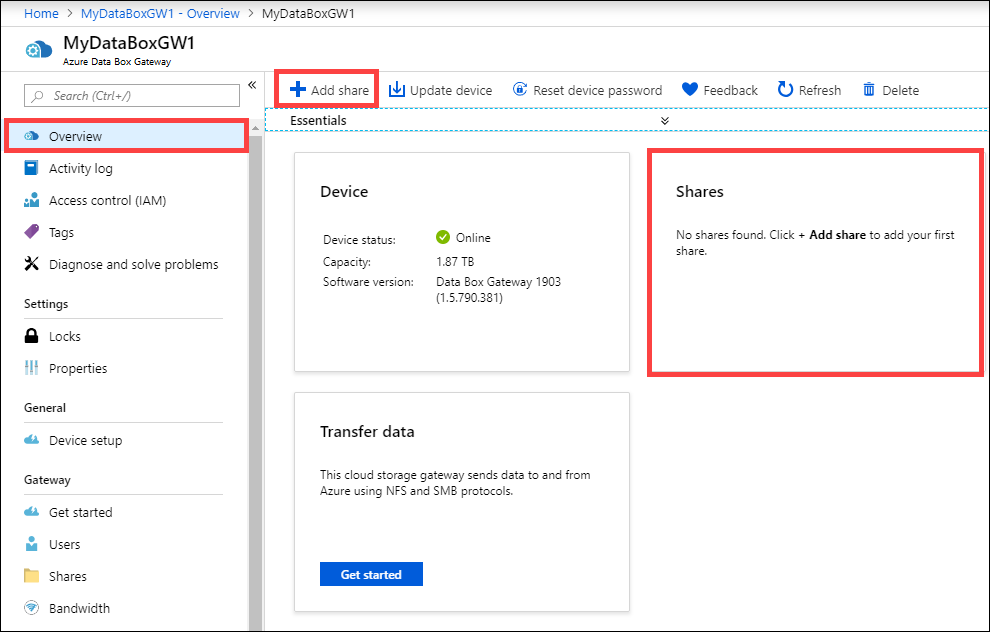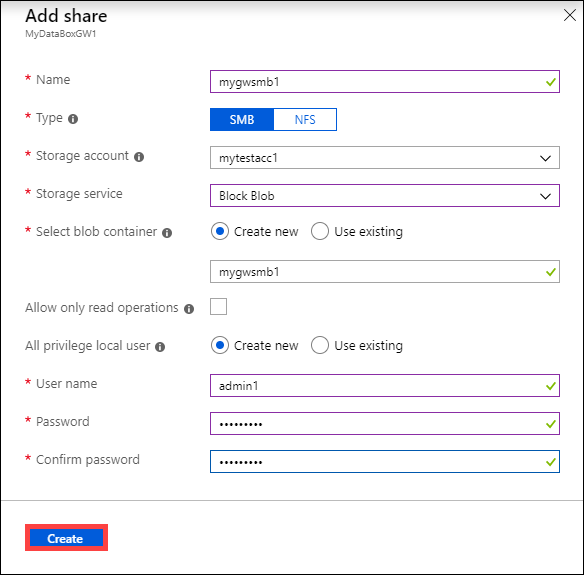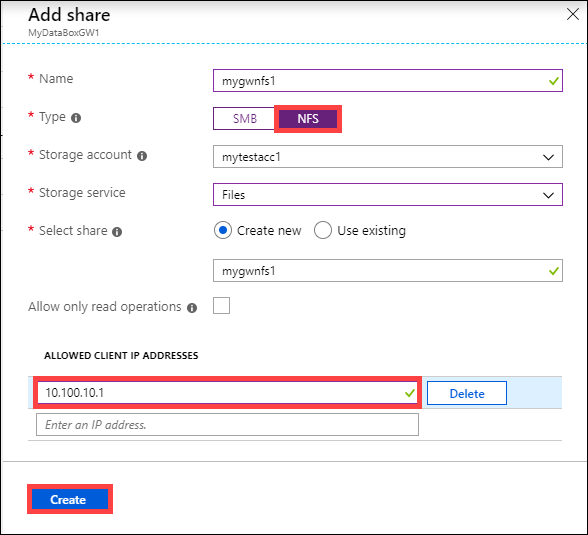Note
Access to this page requires authorization. You can try signing in or changing directories.
Access to this page requires authorization. You can try changing directories.
Introduction
This article describes how to add and connect to shares on your Data Box Gateway. After you've added the shares, the device can transfer data to Azure.
This procedure can take around 10 minutes to complete.
In this tutorial, you learn how to:
- Add a share
- Connect to share
Prerequisites
Before you add shares to your Data Box Gateway, make sure that:
You've provisioned a virtual device and connected to it as detailed in the Provision a Data Box Gateway in Hyper-V or Provision a Data Box Gateway in VMware.
You've activated the virtual device described in Connect and activate your Azure Data Box Gateway.
The device is ready for you to create shares and transfer data.
Add a share
To create a share do the following procedure:
In the Azure portal, select your Data Box Gateway resource and then go to Overview. Your device should be online. Select + Add share on the device command bar.

In Add Share, do the following procedure:
Provide a unique name for your share. The share names can only have lowercase letters, numbers, and hyphens. The share name must have between 3 and 63 characters long and begin with a letter or a number. Each hyphen must be preceded and followed by a non-hyphen character.
Select a Type for the share. The type can be SMB or NFS, with SMB being the default. SMB is the standard for Windows clients, and NFS is used for Linux clients. Depending upon whether you choose SMB or NFS shares, options presented are slightly different.
Provide a storage account where the share will reside. If a container doesn't already exist, it's created in the storage account with the newly created share name. If the container already exists, that container is used.
Important
Make sure that the Azure Storage account that you use does not have immutability policies set on it if you are using it with a Data Box Gateway device. For more information, see Set and manage immutability policies for blob storage.
Choose the Storage service from block blob, page blob, or files. The type of the service chosen depends on which format you want the data to reside in Azure. For example, in this instance, we want the data to reside as blob blocks in Azure, hence we select Block Blob. If choosing Page Blob, you must ensure that your data is 512 bytes aligned. For example, a VHDX is always 512 bytes aligned.
This step depends on whether you are creating an SMB or an NFS share.
SMB share - Under All privilege local user, select Create new or Use existing. If you create a new local user, enter a username and password, and then confirm password. This action assigns the permissions to the local user. Modification of share-level permissions is currently not supported.

If you select Allow only read operations check box for this share data, you can specify read-only users.
NFS share - Enter the IP addresses of the allowed clients that can access the share.

Select Create to create the share.
You're notified that the share creation is in progress. After the share is created with the specified settings, the Shares tile updates to reflect the new share.

Connect to the share
You can now connect to one or more of the shares that you created in the last step. Depending upon whether you have an SMB or an NFS share, the steps can vary.
Connect to an SMB share
On your Windows Server client connected to your Data Box Gateway, connect to an SMB share by entering the commands:
In a command window, type:
net use \\<IP address of the device>\<share name> /u:<user name for the share>Enter the password for the share when prompted. The sample output of this command is presented here.
Microsoft Windows [Version 18.8.16299.192) (c) 2017 microsoft Corporation. All rights reserved . C: \Users\GatewayUser>net use \\10.10.10.60\newtestuser /u:Tota11yNewUser Enter the password for 'TotallyNewUser' to connect to '10.10.10.60' The command completed successfully. C: \Users\GatewayUser>On your keyboard, select Windows + R.
In the Run window, specify the
\\<device IP address>and then select OK. File Explorer opens. You should now be able to view the shares that you created as folders. In File Explorer, double-click a share (folder) to view the content. -->
-->The data is written to these shares as it is generated and the device pushes the data to cloud.
Connect to an NFS share
On your Linux client connected to your device, do the following procedure:
Make sure that the client has NFSv4 client installed. To install NFS client, use the following command:
sudo apt-get install nfs-commonFor more information, go to Install NFSv4 client.
After the NFS client is installed, use the following command to mount the NFS share you created on your Data Box Gateway device:
sudo mount -t nfs -o sec=sys,resvport <device IP>:/<NFS shares on device> /home/username/<Folder on local Linux computer>Prior to setting up the mounts, make sure the directories that will act as mountpoints on your local computer are already created and also do not contain any files or sub-folders.
The following example shows how to connect via NFS to a share on Gateway device. The virtual device IP is
10.10.10.60, the sharemylinuxshare2is mounted on the ubuntuVM, mount point being/home/databoxubuntuhost/gateway.sudo mount -t nfs -o sec=sys,resvport 10.10.10.60:/mylinuxshare2 /home/databoxubuntuhost/gateway
Note
The following caveats are applicable to this release:
- After a file is created in the shares, renaming of the file isn't supported.
- Deletion of a file from a share does not delete the entry in the storage account.
- If using
rsyncto copy data, thenrsync -aoption is not supported.
Next steps
In this tutorial, you learned about Data Box Gateway topics such as:
- Add a share
- Connect to share
Advance to the next tutorial to learn how to administer your Data Box Gateway.